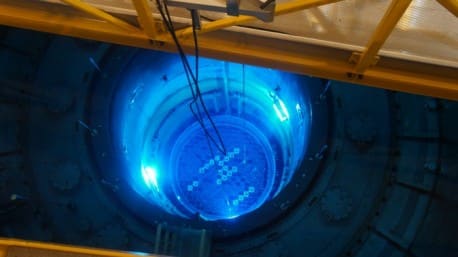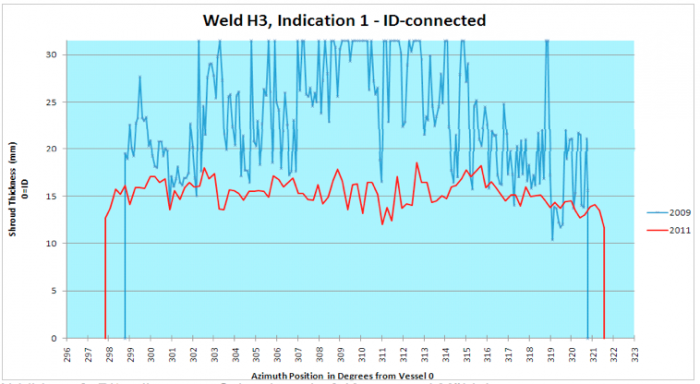The core shroud in the Mühleberg nuclear power plant (KKM) will continue to perform its function without additional measures. New measurements of the fissures in two of the weld seams on the core shroud confirm ENSI’s previous assessment, and prove that the fissures do not penetrate the walls, and do not run all the way round the core shroud. However, ENSI is requesting additional improvement measures for long-term operation.

Fissures in the area of the weld seams on the core shrouds of boiling water reactors (BWR) are well-known phenomena throughout the world, and have been thoroughly studied. In the US, for example, 36 reactors are confronted with this problem, which is exacerbated as the period of operation becomes longer.
In Mühleberg, fissures were detected in the area of the weld seams on the core shroud for the first time in 1990. Since then, the weld seams have been continuously monitored, and any changes in the fissures have been registered with the help of visual inspection techniques as well as eddy current and ultrasound technology. In these ways, the length of the fissures is determined and assessed on the basis of fracture mechanics after each measurement.
In the case of previous measurements, the depth of the fissures was only determined approximately by way of additional information. In order not to incur any risk, it was always assumed, for the purpose of the fracture-mechanical calculations relating to the safety of the core shroud, that the fissures penetrate the walls, even though there were clear indications that this was not the case in reality.
Ultrasonic robots measure fissure depth
This assumption has now been confirmed by the latest studies: for the 2011 inspection shutdown, BKW arranged for the development of the fissures in the core shroud to be examined again by external specialists during recent weeks. For the first time, a new and substantially improved process for ultrasonic testing was used for this purpose. Thanks to the ultrasonic robots that were deployed (Figure 1), the scope of testing could be considerably extended and also – in particular – reliable measurements of the depth of the fissures were made possible.

Result: The fissures definitely do not penetrate the walls
On the basis of the new measurements, the fissures prove to be less deep than was previously assumed. None penetrate the walls and none run around the entire weld seam.
Figure 2: Fissure diagram, weld seam H3 Mühleberg nuclear power plant, 2011

The example of weld seam H3 in Figure 2 shows that the length of the fissure (the horizontal dimension in the diagram) has grown slightly during the two years since the last measurement in 2009. This growth is within the scope of previous expectations. At the same time, the fissure is significantly less deep than was previously assumed. It penetrates about half of the steel casing locally (fissure depth from 12 to 18 mm in a wall thickness of 31 mm).
Second opinion from SATI
On behalf of ENSI, the Swiss Association for Technical Inspection (SATI/SVTI) monitored the measurements of the core shroud at Mühleberg. Its experts followed all the steps of the inspection process on site. The raw data obtained from the ultrasonic testing were independently evaluated and assessed by the SATI.
SATI’s conclusion: “SATI’s results correspond to those obtained by the inspection company.”
In advance of the inspection procedure, the “Swiss Qualification Body for Non-Destructive Evaluation (NDE)” located at SATI subjected the inspection company’s new ultrasonic testing system to systematic verification of performance (qualification) using test objects on a scale of 1:1, with large numbers of test faults of differing sizes. The qualification was successful.
Particular emphasis has been placed on improving the determination of fissure depth in connection with the ongoing development of ultrasound technology and subsequent qualification.
Klaus Dressler, Head of the Nuclear Inspectorate at SATI, summarises the outcome: “The results of core shroud measurements that have now been obtained with the more advanced testing system show that the deepest fissures only extend as far as the middle of the wall.” Regardless of these measurement results, he adds, a depth that would penetrate the wall in the case of all the fissures was still taken as the basis for the fracture-mechanical evaluation of the core shroud, as was also the case in previous evaluations. “The evaluation therefore includes additional safety reserves.”
Safety of the core shroud is guaranteed
The latest test results confirm the assessment made by ENSI’s experts on the basis of previous measurements:
- The core shroud of the KKM continues to perform its function despite the presence of the fissures.
- The Mühleberg nuclear power plant can continue to be operated safely in the medium term, provided that there are ongoing measurements and fracture-mechanical evaluations of the fissures. No additional measures are required in the short term.
- The development of the fissures must continue to be monitored on an ongoing basis.
This safety assessment applies to the operation of KKM in the short and medium terms. The long-term aspects are being evaluated by ENSI as part of the technical safety assessment of long-term operation.
ENSI requires a long-term solution
Several years ago, BKW installed four so-called anchor bolts (a type of large clamp) in case of an unexpected tear affecting the entire weld seam that is contrary to the measurement results and calculations. Similar solutions are accepted as definitive repair measures in several countries throughout the world, including the US.
In 2006, the design of the anchor bolts at KKM was assessed by ENSI, which called in TÜV Nord for this purpose. ENSI did not accept the current solution with the four anchor bolts for the purposes of long-term operation, and it requested a maintenance concept for the core shroud. BKW submitted a new concept in the meantime, and ENSI will issue its comment on this by the end of this year.